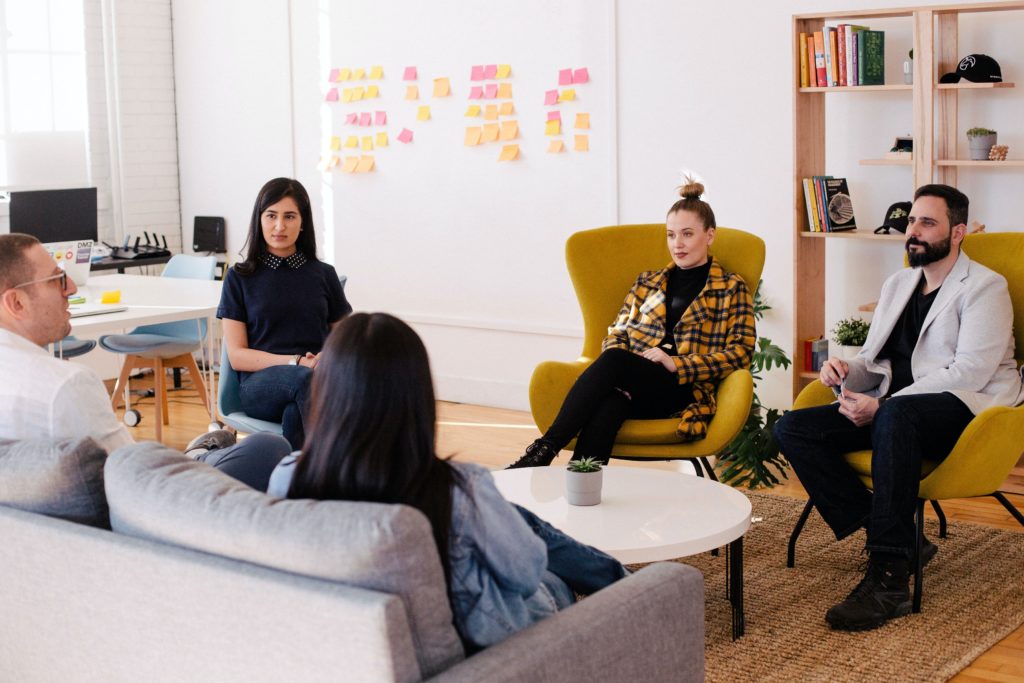A Long Game Leads to Arts Education Policy Change

Five people are seated in a naturally lit room for a collaborative meeting. In the background, someone has attached a series of sticky notes for a brainstorming session, and there is a computer desk as well as a bookcase with a variety of books and other home decor. Photo Credit: Leon on Unsplash
Over my years as an arts educator in California, I have learned that making significant changes in arts education policy is a long game that depends on the work of a diverse, collaborative group with perseverance, timing and ongoing communication.
Arts and arts integration have been part of education for many years, but beginning in the 1960s, they were sidelined because of the perception that the nation needed to teach more science and math. The arts were drastically cut in California schools in 1978 because of a state initiative which changed school funding formulas.
Since then, many individuals and groups continue to work for arts education. The arts became an integral part of teacher preparation following work by practitioners like Dr. Paul Ammon, an education professor at the University of California, Berkeley. His interest began seriously in 2005 with a California Council on Teacher Education conference, “Artful Teaching in Testy Times,” presented as a balance to the standardized testing promoted by federal policymakers. Around the same time, Dr. Ammon received a grant from the Ford Foundation’s Arts Education Initiative. With this grant he brought together teacher preparation educators in Northern California with interest and experience in arts education.
I joined Dr. Ammon’s group shortly after being hired at California State University East Bay to teach arts methods, notable because few California teacher training programs included tenure-line positions in the field. In general, the arts were not valued in teacher education in California. When it came to training elementary teachers, these preparation programs either ignored the arts or inserted them into coursework in a scattershot manner. This was not due to any concerted effort to diminish the arts but a lack of knowledge about the field.
I also got involved with the California Council on Teacher Education. Cal Council convenes most teacher education programs and faculty in the state and serves as an organization to build initiatives, share current research and advocate for policy. Staff members from California’s teacher education oversight and accrediting agency — the Commission on Teacher Credentialing — attend and are available for conversations with attendees.
Taking advantage of these networking opportunities, Dr. Ammon, the group of educators he had convened and other like-minded Cal Council members started conversations with Commission staff about including arts/arts integration in an upcoming, major revision of the California Teacher Performance Expectations. All teacher preparation programs must teach the teacher performance expectations as they are the basis for program accreditation from the state.
At first, the staff did not seem convinced of the importance of the arts. In response, Dr. Ammon and a diverse group of teacher preparation educators from across the state proposed to the Cal Council Board to lead one of the regular conferences around the theme of arts education, which was approved.
A year of planning by the group led to “Transforming Teacher Education Through the Arts” in 2014. After the conference, the conversations with the Commission staff changed in tone. The research, keynote address and hands-on learning activities presented at the conference convinced Commission staff of the value of arts education/integration in teacher preparation.
The Commission released the new teacher performance expectations in 2017, which included two that specifically addressed arts learning: one focused on “incorporating the arts” and the other on “integrating the arts.” The arts education community consider this a major victory. Being embedded in performance expectations means there is accountability that arts are taught through the on-going re-accreditation process.
But one policy “win” does not complete the work. Subsequent research showed that teacher preparation programs are not skilled in integrating the arts and that universities and organizations should provide ongoing professional development to faculty who teach in these programs.
The successful completion of the process of adding arts/arts integration to preservice teaching requirements in California took over 12 years. It required the dedication of a diverse group of teacher preparation faculty communicating to and educating policymakers. While some luck was involved, such as the timing of when the teacher performance expectations were revised, it was accomplished by hard work, research, communication and collaborative actions.
This post is written in collaboration with the Arts Education Partnership Higher Education Working Group.



